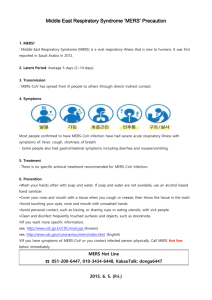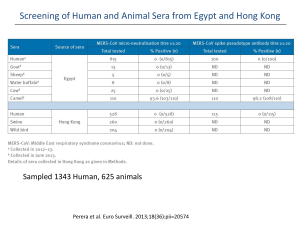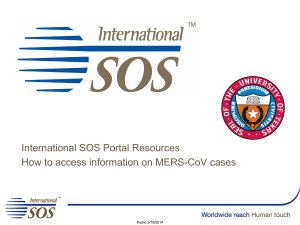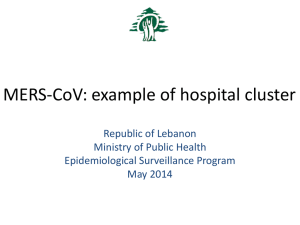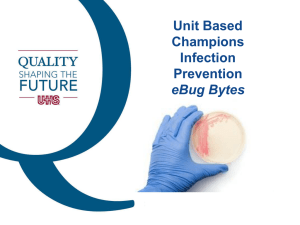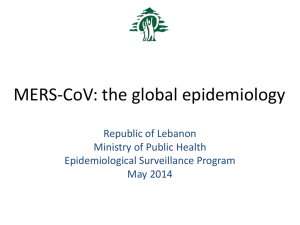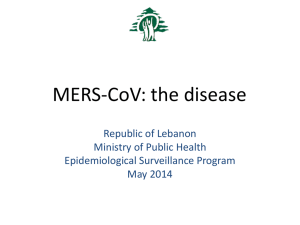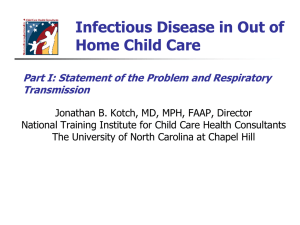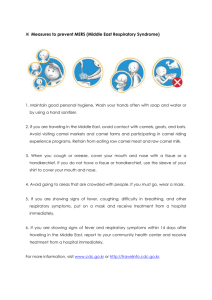MERS - Ministry of Health
advertisement
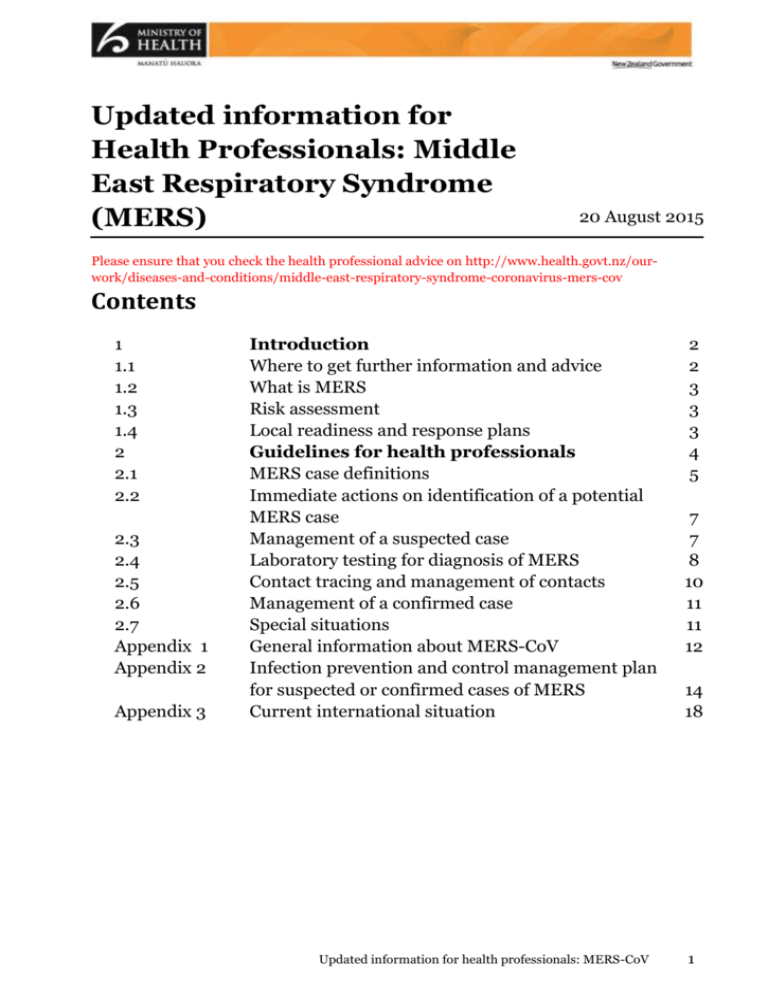
Updated information for
Health Professionals: Middle
East Respiratory Syndrome
(MERS)
20 August 2015
Please ensure that you check the health professional advice on http://www.health.govt.nz/ourwork/diseases-and-conditions/middle-east-respiratory-syndrome-coronavirus-mers-cov
Contents
1
1.1
1.2
1.3
1.4
2
2.1
2.2
2.3
2.4
2.5
2.6
2.7
Appendix 1
Appendix 2
Appendix 3
Introduction
Where to get further information and advice
What is MERS
Risk assessment
Local readiness and response plans
Guidelines for health professionals
MERS case definitions
Immediate actions on identification of a potential
MERS case
Management of a suspected case
Laboratory testing for diagnosis of MERS
Contact tracing and management of contacts
Management of a confirmed case
Special situations
General information about MERS-CoV
Infection prevention and control management plan
for suspected or confirmed cases of MERS
Current international situation
Updated information for health professionals: MERS-CoV
2
2
3
3
3
4
5
7
7
8
10
11
11
12
14
18
1
1
Introduction
This document provides updated information and guidance concerning Middle East Respiratory
Syndrome (MERS) which is complementary to or, where there are differences, supersedes the
information provided in the Communicable Disease Control Manual 2012
(www.health.govt.nz/publication/communicable-disease-control-manual-2012).
Middle East Respiratory Syndrome (MERS) is an illness caused by a virus (more specifically, a
coronavirus http://www.cdc.gov/coronavirus/index.html) called Middle East Respiratory Syndrome
Coronavirus (MERS-CoV). MERS affects the respiratory system (lungs and breathing tubes). Most
MERS patients developed severe acute respiratory illness with symptoms of fever, cough and
shortness of breath. About 2-4 out of every 10 patients reported with MERS have died.
Since 2012 cases of MERS have been confirmed and notified to the World Health Organization
(WHO). Cases of MERS-CoV infection have been reported in Several Middle Eastern countries. Other
countries, including recently South Korea, have also reported cases of MERS-CoV infection. All cases
outside the Middle East have either lived in or travelled to affected countries, had close contact with
travellers returning from the Middle East and/or contact with a person with MERS.
Although sustained person-to-person transmission has not been observed in communities, secondary
transmission particularly in healthcare settings has frequently been reported. Therefore, ongoing
efforts to contain the nosocomial clusters occurring are important in the prevention of wider
transmission. People who are most vulnerable to MERS are those with co-morbidities (i.e. chronic
disease). These people are more likely to visit health facilities, and, if infected, more likely to have a
severe disease and be able to spread the virus more effectively.
Updated information on case numbers and countries that have reported cases is available on the WHO
coronavirus infection website (http://www.who.int/csr/disease/coronavirus_infections/en/).
This information in this document is largely based on advice from the World Health Organization
(WHO), The European Centre for Disease Prevention and Control, United States Centers for Disease
Control and prevention, Communicable Disease Network Australia and Public Health England. The
Ministry has also sought input from technical experts in New Zealand.
Intended users of this guidance are health care workers, laboratory workers and others, including
those involved in contact tracing who may come into contact with a suspected or confirmed case of
MERS-CoV infection.
1.1
Where to get further information and advice
Please see the webpages below for the latest information:
General information for the public:
– www.health.govt.nz/our-work/diseases-and-conditions/middle-east-respiratory-syndromecoronavirus-mers-cov
Situation updates:
- http://www.who.int/emergencies/mers-cov/en/
General information about MERS-CoV can also be found in Appendix 1 of this document.
2
Information for health professionals: MERS August 2015
1.2 What is MERS?
Coronaviruses are a large and diverse family of viruses which include viruses that are known to cause
illness in humans (including the common cold and severe acute respiratory syndrome {SARS}) and
animals. The Middle East Respiratory Syndrome coronavirus (MERS-CoV), had not previously been
detected in humans or animals but appears most closely related to coronaviruses previously found in
bats. It is genetically distinct from the SARS-CoV and appears to behave differently. There is
experimental evidence supporting dromedary camels as the primary reservoir of MERS-CoV.
Numerous sporadic human cases reported to date have had a history of close contact with camels.
MERS is a notifiable disease under the Health Act 1956. The attending medical practitioner should
immediately notify any potentially suspected case and the laboratory any result positive for MERSCoV to the local medical officer of health. The medical officer of health should inform the Office of the
Director of Public Health by phone and email.
Any contacts of a probable or confirmed case should also be reported to the local medical officer of
health.
MERS is also a quarantinable infectious disease. This allows the full range of quarantine provisions to
be used to manage suspected cases and contacts at the border and for the provisions of the Epidemic
Preparedness Act 2006 to apply, if required. The Ministry would notify the World Health Organization
(WHO) of a case of MERS under the International Health Regulations, 2005.
1.3 Risk assessment
The Ministry’s risk assessment is that currently the risk of a MERS-CoV infection outbreak is low in
New Zealand. This assessment however recognises that there is an ongoing risk of MERS-CoV
infection being imported into New Zealand, especially during periods of increased disease activity and
travel to affected countries in the Arabian Peninsula. Because of the continued risk of importation of
cases to New Zealand after exposure in the Middle East (or possibly in another area with on-going
outbreak), awareness of MERS among travellers and health care professionals is essential.
The recent situation in South Korea reinforces the importance of rapidly obtaining a travel history and
contact from patients and implementing strict infection prevention and control measures in hospital
settings to interrupt transmission and prevent clusters of healthcare-associated infections. The
challenges around the early detection of rare imported cases of respiratory infection highlight the
importance of implementing adequate infection prevention and control measures for all patients
showing symptoms of acute respiratory infection.
1.4 Local readiness and response plans
District health boards (DHBs) should already have local readiness and response plans in place.
Operational guidelines for public health unit border health protection officers (Medical Officers of
Health or Health Protection Officers) who may be required to manage ill travellers are available on the
Health Emergency Management Information System (EMIS). Please contact your DHB Emergency
Planner for further information on Health EMIS if required.
Information for health professionals: MERS August 2015
3
2
Guidelines for health
professionals
2.1 MERS case definitions
The current case definitions for MERS are listed on the next page.
It is important that health professionals phone their local public health unit for advice
for any person whose history and symptoms raise concern whether or not the person
meets the formal definition of a suspected case of MERS.
Health professionals working in primary care should also contact their local public
health unit for advice before requesting any MERS tests.
People who are most vulnerable to MERS are those with co-morbidities (i.e. chronic disease). These
people are more likely to visit health facilities, and, if infected, more likely to develop a severe disease
and be able to spread the virus more effectively.
4
Information for health professionals: MERS August 2015
Case definitions for MERS
1. Under investigation
A person who has been referred to the public health service for investigation of possible MERS-CoV
infection.
2. Suspected case
Clinical description
Epidemiological Risk
Severe illness
A person with fever
(temperature 38OC or
above) AND pneumonia
or pneumonitis or acute
respiratory distress
syndrome (ARDS)1
AND
Milder illness
AND
A person with fever
(temperature 38OC or
above) AND symptoms of
respiratory illness (e.g.
cough, shortness of
breath)
OR
lower risk:
a history of residence in, or travel to, potentially affected countries in
the Middle East2 within 14 days before symptom onset,
OR
close contact3 within 14 days before symptom onset with a
symptomatic person who developed fever and acute respiratory illness
of unknown aetiology within 14 days after travelling from the
potentially affected countries in the Middle East2 or from a region with
a known MERS-CoV outbreak at that time4,
OR
is part of a cluster of severe acute respiratory illness of unknown
aetiology.
higher risk:
a history of being in a healthcare facility (as a patient, worker, or
visitor) in a potentially affected country in the Middle East2 or a
country with recent healthcare-associated cases of MERS4 within 14
days before symptom onset,
OR
a history of contact with camels or raw camel products within affected
countries in the Middle East2 within 14 days before symptom onset.
Severe illness (as
above)
Identified contacts of a probable or confirmed case
A person with fever
AND onset within 14 days after close contact3 with a probable or confirmed
O
(temperature 38 C or
MERS case while the case was ill.
above) OR acute
symptoms compatible
with MERS
Immunocompromised patients may not present with typical symptoms.
2
Potentially affected countries in the Middle East include:
countries with locally acquired cases resulting from zoonotic, environmental, or unknown source transmission, whether
or not they have been followed by further transmission, i.e. Jordan, Kuwait, Oman, Qatar, Saudi Arabia, Lebanon,
Yemen, Iran and the United Arab Emirates (UAE),
neighbouring countries with health services affected by civil unrest, i.e. Iraq and Syria.
Whenever available, recent epidemiological information on MERS in Middle East countries should be taken into account. Please
refer in particular to World Health Organization (WHO) coronavirus website http://www.who.int/emergencies/mers-cov/en/.
Transiting through an international airport (<24 hours stay, remaining within the airport) in these countries is not considered to
be risk factor for infection.
3
Close contact includes:
anyone who provided care for or handled clinical samples/respiratory secretions from the patient, including a health care
worker or family member, or who had other similarly close physical contact without the recommended infection control
precautions;
anyone who had a prolonged (>15 minutes) face-to-face contact with, or stayed at the same place (e.g. lived or worked
with, visited) as a probable or confirmed case while the case was ill without the recommended infection control
precautions;
where a case has travelled on an airplane or any other conveyance while ill, close contacts include passengers seated in
the same row as the case and two rows in front and behind the case, and crew or passengers that have had face-to-face
prolonged interaction (e.g. 15 minutes) with, or contact with respiratory secretions of the ill person.
4
Please refer to the WHO coronavirus infection website http://www.who.int/emergencies/mers-cov/en/.
Information for health professionals: MERS August 2015
5
3. Probable Case
a person with an acute febrile respiratory illness with clinical, radiological, or histopathological
evidence of pulmonary parenchymal disease (e.g. pneumonia or Acute Respiratory Distress
Syndrome)5
AND
no possibility of laboratory confirmation for MERS-CoV either because the patient or samples are not
available for testing
AND
close contact with a laboratory-confirmed case
4. Confirmed Case
a person with laboratory confirmation of infection with MERS-CoV 6.
5
Immunocompromised patients may not present with typical symptoms.
Currently confirmatory testing requires molecular diagnostics including either a positive PCR on at least two specific genomic
targets or a single positive target with sequencing on a second. However, WHO interim recommendations for laboratory testing
for MERS-CoV should be consulted for the most recent standard for laboratory confirmation. Please refer to:
http://www.who.int/csr/disease/coronavirus_infections/mers-laboratory-testing/en/.
6
6
Information for health professionals: MERS August 2015
2.2
Immediate actions on identification of a
potential MERS case
Case under investigation
At the health facility level, standard precautions for the management of a patient with respiratory
illness should apply.
If there is no need for hospitalisation, a person under investigation should be provided with
respiratory etiquette guidance, avoid health and aged care facilities and have otherwise no
limitations to daily living activities. This advice is based on the low probability of having a case in
New Zealand and the low probability of disease spread outside healthcare settings. However on a
case by case basis, public health staff may require restrictions for cases under investigation.
While a case remains under investigation the person should monitor themselves and contact the
local public health unit if they develop more severe symptoms. The person under investigation
should remain easily contactable by the public health unit and within reasonable distance of a
hospital until the investigation is completed.
As soon as a person under investigation is found to meet the suspected case
definition, they should be managed as a suspected case.
Suspected case
A person meeting the suspected case definition should be place in a negative pressure room if
available or single room as a minimum.
Use standard contact and airborne transmission-based precautions, including the use of personal
protective equipment (PPE). See Appendix 2 for detailed Infection Prevention and Control
Guidance.
2.3 Management of a suspected case
Initial assessment of cause of symptoms should include a risk assessment for MERS and for other
diagnoses which may present in similar ways. Including other respiratory diseases.
Care for MERS is supportive as there is no specific approved vaccine or therapeutic (antiviral drug)
options currently available.
If a potentially suspected case presents in a primary care setting, the local Medical Officer of Health
must be contacted immediately.
Every secondary and tertiary hospital in the country is expected to be able to identify a suspected
MERS case and provide patient care, and must immediately contact the local Medical Officer of
Health.
As with all respiratory illnesses, there may be occasions were a deteriorating patient may need to be
transferred to a tertiary hospital. This decision would be made by the clinical team as per normal.
A suspected case may be released from isolation and discharged if the medical condition allows
after testing negative for MERS-CoV, unless a high index of suspicion remains of another
transmissible infectious respiratory disease.
Updated information for health professionals: MERS-CoV
7
2.4 Laboratory testing for diagnosis of MERS
Who do I test for MERS?
Testing should be considered for:
1.
Individuals with fever (temperature 38OC or above) and severe acute respiratory illness, and
history of residence in, or travel to, the potentially affected countries in the Middle East7 within 14
days before onset of illness.
2.
Individuals with fever (temperature 38OC or above) and severe acute respiratory illness, and close
contact8 within 14 days before symptom onset with a symptomatic person who developed fever
and acute respiratory illness of unknown aetiology within 14 days after travelling from the
potentially affected countries in the Middle East7 or from a region with a known MERS-CoV
outbreak at that time9.
3.
Individuals with fever (temperature 38OC or above) and symptoms of respiratory illness (e.g.
cough, shortness of breath) and a history of being in a healthcare facility (as a patient, worker, or
visitor) in a potentially affected country in the Middle East7 or a country with recent healthcareassociated cases of MERS9 within 14 days before symptom.
4.
Individuals with fever (temperature 38OC or above) and symptoms of respiratory illness (e.g.
cough, shortness of breath) and a history of contact with camels or raw camel products within
affected countries in the Middle East7 within 14 days before symptom onset.
5.
Identified close contacts8 of probable or confirmed cases with fever (temperature 38OC or above)
or acute symptoms compatible with MERS. If an outbreak occurs in a health-care facility, all
asymptomatic close contacts should also be tested. 10
6.
A cluster of people with fever (temperature 38OC or above) and severe acute respiratory illness of
unknown aetiology (in health workers in particular).
Clinicians should be aware that immunocompromised patients may not present with typical
symptoms.
7
Potentially affected countries in the Middle East include:
countries with locally acquired cases resulting from zoonotic, environmental, or unknown source transmission,
whether or not they have been followed by further transmission, i.e. Jordan, Kuwait, Oman, Qatar, Saudi Arabia,
Lebanon, Yemen, Iran and the United Arab Emirates (UAE),
neighbouring countries with health services affected by civil unrest, i.e. Iraq and Syria.
Whenever available, recent epidemiological information on MERS in Middle East countries should be taken into
account. Please refer in particular to World Health Organization (WHO) coronavirus website
http://www.who.int/emergencies/mers-cov/en/.
Transiting through an international airport (<24 hours stay, remaining within the airport) in these countries is not
considered to be risk factor for infection.
8
Close contact includes:
anyone who provided care for or handled clinical samples/respiratory secretions from the patient, including a
health care worker or family member, or who had other similarly close physical contact without the recommended
infection control precautions;
anyone who had a prolonged (>15 minutes) face-to-face contact with, or stayed at the same place (e.g. lived or
worked with, visited) as a probable or confirmed case while the case was ill without the recommended infection
control precautions;
where a case has travelled on an airplane or any other conveyance while ill, close contacts include passengers
seated in the same row as the case and two rows in front and behind the case, and crew or passengers that have
had face-to-face prolonged interaction (> 15 minutes) with, or contact with respiratory secretions of the ill person.
9 Please refer to the WHO coronavirus infection website http://www.who.int/emergencies/mers-cov/en/.
10
8
Please refer to “Outbreaks in health care facilities” further in this document.
Information for health professionals: MERS August 2015
Please contact your local public health unit for advice for any person whose history
and symptoms raise concern whether or not the person meets the formal definition of
a suspected case of MERS.
Health professionals working in primary care should also contact their local public
health unit for advice before requesting any MERS tests.
Any cluster of severe acute respiratory infection in health care settings should be
thoroughly investigated.
Testing must also be carried out to confirm clearance of the virus in confirmed and clinically recovered
cases.
How do I test for MERS-CoV?
WHO interim recommendations on laboratory testing for MERS-CoV can be found on the WHO
website at http://www.who.int/csr/disease/coronavirus_infections/mers-laboratory-testing/en/.
Routine tests for acute pneumonia should be performed where indicated, including bacterial
culture, serology, urinary antigen testing and tests for respiratory viruses, including influenza.
This testing should not delay testing for MERS-CoV.
It is recommended that both upper and lower respiratory tract specimens be collected whenever
possible. There is considerable evidence that lower respiratory tract specimens such as
bronchoalveolar lavage, sputum and tracheal aspirates contain the highest viral loads and these
should be collected when possible. A report of a case series of MERS-CoV infections detected in
Saudi Arabia has also demonstrated the importance of upper respiratory tract specimens such as
nasopharyngeal/oropharyngeal swabs for detecting the virus. If initial testing of a nasopharyngeal
swab is negative in a patient strongly suspected to have MERS-CoV infection, consideration
should be given to retesting using a lower respiratory specimen.
Respiratory samples including upper respiratory tract viral swabs, nasopharyngeal swabs and
aspirates, sputum, endotracheal aspirate, bronchoalveolar lavage fluid, lung biopsies and postmortem tissues are suitable for testing for MERS-CoV.
To increase the likelihood of detecting the virus, multiple sampling over time and also from
multiple sites over the course of the illness should be considered (depending on the individual
patient). Even after the initial detection of the virus, continued sampling and testing will add to
current knowledge about the duration of virus shedding and is strongly encouraged. Virus has
been detected in urine and faeces but at levels below those found in the lower respiratory tract. To
date, there is little information on the value of whole blood as a specimen for MERS-CoV
detection.
Standard, contact and airborne precautions should be followed when collecting specimens. The
collection of specimens should occur in an airborne infection isolation room if available. Hand
hygiene should be performed in accordance with the ‘5 moments for hand hygiene’.
Laboratory staff should handle clinical specimens under PC2 conditions in accordance with
AS/NZS 2243.3:2010 Safety in Laboratories Part 3: Microbiological Safety and Containment.
However, viral isolation for a PCR-confirmed specimen should be handled under PC3 conditions.11
Currently confirmatory testing requires molecular diagnostics including either a positive PCR on
at least two specific genomic targets or a single positive target with sequencing on a second.
However, WHO interim recommendations for laboratory testing for MERS-CoV should be
11
WHO interim recommendations for laboratory biorisk management, also at
http://www.who.int/csr/disease/coronavirus_infections/mers-laboratory-testing/en/
Information for health professionals: MERS August 2015
9
consulted for the most recent standard for laboratory confirmation. WHO also has additional
notes regarding inconclusive and clearance testing.
While PCR testing for MERS-CoV may be undertaken in any PC2 laboratory, positive samples
should be sent to Institute of Environmental Science and Research (ESR) for confirmatory testing.
The Ministry contracts the ESR to provide microbiological reference and specialised testing for
communicable diseases, which includes MERS-CoV. Samples should therefore be referred to the
ESR Clinical Virology Laboratory at the National Centre for Biosecurity and Infectious Diseases
(NCBID), Wallaceville, for free confirmatory testing. The laboratory should be notified about the
referral and samples should be transported in accordance with current regulatory requirements.
Please refer to the Annex for the procedure for shipping respiratory samples.
Serological tests for MERS-CoV have been developed overseas (see WHO laboratory document).
Serological tests may be useful in those strongly suspected of having MERs-CoV but who have not
had a diagnosis confirmed with nucleic acid tests or in special sero-epidemiological studies. At the
time of this guidance serological testing for MERS-CoV is not available in New Zealand.
2.5 Contact tracing and contact management
Purpose of contact tracing
Contact tracing is required for the prevention of onward transmission, awareness-raising and early
detection of suspected cases. This will be coordinated by the local public health unit.
Close contact includes:
anyone who provided care for or handled clinical samples/respiratory secretions from the patient,
including a health care worker or family member, or who had other similarly close physical contact
without the recommended infection control precautions;
anyone who had a prolonged (>15 minutes) face-to-face contact with, or stayed at the same place
(e.g. lived or worked with, visited) as a probable or confirmed case while the case was ill without
the recommended infection control precautions;
where a case has travelled on an airplane or any other conveyance while ill, close contacts include
passengers seated in the same row as the case and two rows in front and behind the case, and crew
or passengers that have had face-to-face prolonged interaction (e.g. 15 minutes) with, or contact
with respiratory secretions of the ill person.
Management
Please note that during outbreaks in health care settings WHO recommends a more cautious approach
to contact management: please refer to “Outbreaks in health care facilities” below.
Investigation
Close contacts of probable and confirmed cases should be actively monitored by the public health unit
daily and asked to report symptoms such as fever, respiratory symptoms, headache, muscle pain or
diarrhoea develop to their local public health unit. They should be tested for MERS-CoV infection if
respiratory symptoms develop (regardless of the severity of illness).
Restriction
In general quarantine of asymptomatic contacts is not required as current evidence shows limited
person-to-person transmission of MERS-CoV.
10
Information for health professionals: MERS August 2015
On a case by case basis, public health staff may also require additional restrictions for close contacts.
Counselling
Advise all contacts of the estimated incubation period and typical symptoms of MERS. Encourage
them to contact their local public health unit and seek early medical attention if symptoms develop.
2.6 Management of a confirmed case of MERS
The case should remain negative pressure room.
Use standard, contact and airborne precautions. , including the use of personal protective
equipment (PPE). See Appendix 2 for detailed Infection Prevention and Control Guidance.
There is insufficient information to make generic treatment recommendations and patients have to
be assessed on a case by case basis.
To confirm clearance of the virus, respiratory samples should continue to be collected until there
are two consecutive negative results in clinically recovered persons. The frequency of specimen
collection should be at least every 2-4 days. If the release of a patient from an isolation ward
requires consecutive negative RT-PCR results, specimens can be collected daily.12
2.7 Special situations
Outbreaks in health care facilities
WHO recommends a cautious approach during outbreaks in health care settings. All close contacts
of a laboratory-confirmed case, especially inpatients sharing rooms/wards with the confirmed case
and health care workers, should be tested for MERS-CoV using PCR regardless of the development
of symptoms. Asymptomatic PCR positive persons should be isolated (at home or in hospital),
followed-up for symptoms and tested at least weekly, or when symptoms develop. 13
If one or more suspected, probable or confirmed MERS cases are identified in a healthcare facility,
an outbreak management team should be convened; including a senior facility manager, an
infection control practitioner and appropriate clinical staff, in consultation with the local public
health unit. Control measures may include:
o
identification, testing and monitoring of close contacts.
o
active case finding and treatment
o
isolation and/or cohorting
o
work restriction for health care workers who have had close contact (ie, unprotected
exposure) with a suspected, probable or confirmed case
o
distribution of fact sheets and other information
o
epidemiological studies to determine risks for infection.
Any clusters of severe acute respiratory infection, in particular in health-care workers, should be
thoroughly investigated.
12
Please refer to WHO interim recommendations on laboratory testing for MERS-CoV at
http://www.who.int/csr/disease/coronavirus_infections/mers-laboratory-testing/en/.
13
Please refer to the WHO interim guidance on surveillance for human infection with MERS-CoV at
http://www.who.int/csr/disease/coronavirus_infections/surveillance-human-infection-mers/en/, and the interim
guidance on the management of asymptomatic persons who are RT-PCR positive for MERS-CoV
http://www.who.int/csr/disease/coronavirus_infections/management_of_asymptomatic_patients/en/ .
Information for health professionals: MERS August 2015
11
Appendix 1: General information about MERS
Middle East Respiratory Syndrome (MERS) is an illness caused by a virus (more specifically, a
coronavirus (http://www.cdc.gov/coronavirus/index.html)) called Middle East Respiratory Syndrome
Coronavirus (MERS-CoV). MERS affects the respiratory system (lungs and breathing tubes). Most
MERS patients developed severe acute respiratory illness with symptoms of fever, cough and
shortness of breath. About 3-4 out of every 10 patients reported with MERS have died.
Health officials first reported the disease in Saudi Arabia in September 2012. Through retrospective
investigations, health officials later identified that the first known cases of MERS occurred in Jordan
in April 2012. So far, all cases of MERS have been linked back to countries in and near the Arabian
Peninsula.
MERS-CoV has spread from ill people to others through close contact, such as caring for or living with
an infected person.
MERS can affect anyone. MERS patients have ranged in age from younger than 1 to 99 years old.
However, people who are most vulnerable to MERS are those with co-morbidities (i.e. chronic
disease). These people are more likely to visit health facilities, and, if infected, more likely to have a
severe disease and be able to spread the virus more effectively.
Transmission
MERS-CoV, like other coronaviruses, is thought to spread from an infected person’s respiratory
secretions, such as through coughing. However, the precise ways the virus spreads are not currently
well understood.
Person-to-person spread of MERS-CoV, usually after close contact, such as caring for or living with an
infected person, has been well documented. Infected people have spread MERS-CoV to others in
healthcare settings, such as hospitals. Researchers studying MERS have not seen any ongoing
spreading of MERS-CoV in the community.
All reported cases have been linked to countries in and near the Arabian Peninsula. Most infected
people either lived in the Arabian Peninsula or recently traveled from the Arabian Peninsula before
they became ill. A few people became infected with MERS-CoV after having close contact with an
infected person who had recently traveled from the Arabian Peninsula.
Public health agencies continue to investigate clusters of cases in several countries to better
understand how MERS-CoV spreads from person to person.
It has been shown that MERS-CoV can survive on surfaces for up to 48 hours.
Incubation period, signs and symptoms
Most people confirmed to have MERS have had severe acute respiratory illness with symptoms of:
fever
cough
muscle pain
shortness of breath
Some people also had gastrointestinal symptoms including diarrhea and nausea/vomiting. For many
people with MERS, more severe complications followed, such as pneumonia and kidney failure. About
2-4 out of every 10 people reported with MERS have died. Most of the people who died had an
12
Information for health professionals: MERS August 2015
underlying medical condition. Some infected people had mild symptoms (such as cold-like symptoms)
or no symptoms at all; they recovered.
Based on what researchers know so far, people with pre-existing medical conditions (also called
comorbidities) are more likely to experience severe disease. Pre-existing conditions from reported
cases for which we have information have included diabetes; cancer; and chronic lung, heart, and
kidney disease. Individuals with weakened immune systems are also at higher risk for having a severe
case.
Based on information we have to date, the incubation period for MERS (time between when a person
is exposed to MERS-CoV and when they start to have symptoms) is usually about 5 or 6 days, but can
range from 2-14 days.
Information for health professionals: MERS August 2015
13
Appendix 2: Infection prevention and control
management plan for suspected or confirmed
cases of MERS
Purpose
This guideline outlines the infection prevention and control measures for patients with suspected or
confirmed MERS-CoV infection.
As in all cases steps should be taken to ensure that all persons with symptoms of respiratory infection
adhere to respiratory hygiene, cough etiquette and hand hygiene.
It is important that patients identified as at risk of having MERS-CoV infection are identified and
isolated early.
These guidelines are based on the available information and the following considerations:
the lack of a safe and effective vaccine for MERS-CoV
incomplete information about transmission of MERS-CoV
a relatively high reported rate of morbidity and mortality among MERS-CoV infected patients
absence of confirmed or probable MERS cases in New Zealand
the international situation with documented nosocomial infection
concern for health and safety of healthcare workers
diagnosis initially not known
patient may have another respiratory illness than MERS.
Guideline principles and goals
This guideline takes a precautionary approach and recommends a high level of infection prevention
and control measures for the reasons listed above. As more information becomes known about the
situation, changes may be made to the infection prevention recommendations.
The guideline provides infection prevention and control guidance for all staff members when in close
contact with a patient either suspected or confirmed to have MERS
Key documents this guidance is based on
1.
CDC. Interim Infection prevention and control recommendations for hospitalised patients with
Middle East Respiratory Syndrome Coronavirus (MERS-CoV). Updated June 2015.
www.cdc.gov/coronavirus/mers/infection-prevention-control.html.
2. Public Health England. MERS-CoV: infection control guidance for possible or confirmed cases.
June 2013: https://www.gov.uk/government/publications/merscov-infection-control-forpossible-or-confirmed-cases.
3. World Health Organization. Clinical management of severe acute respiratory infection when Middle
East respiratory syndrome coronavirus (MERS-CoV) infection is suspected Interim guidance, July
2015: http://www.who.int/csr/disease/coronavirus_infections/case-management-ipc/en/.
14
Information for health professionals: MERS August 2015
Infection prevention and control
Infection control measures should be those applicable to control the transmission of pathogens that
can be spread by the contact, droplet and airborne route.
Any person entering the room must adhere to the correct infection prevention and control procedures
and must be made aware of the potential transmission risks and factors that are known to increase the
risk of severe disease (eg co-morbidities).
1.
Maintain a log of all people entering the room.
Use of a checklist to ensure that all people (including visitors) entering the clinical care area use
personal protective equipment (PPE) correctly – the wearing of correct PPE and the safe removal
of PPE.
2. Ensure appropriate signage is displayed.
Patient placement
The patient should be placed in an airborne infection isolation room (negative pressure room). An
ante room and en-suite bathroom is desirable. Note: If a negative pressure room is not available, at
a minimum, a single room with the door closed, should be used until transfer to a negative pressure
room is possible.
It is important that there is adequate space to allow for placement of PPE, infectious waste bins and
disposable/single-patient use equipment for use with patient care.
Limit the movement and transport of the patient from the room to essential purposes only. If the
patient is to be transported out of the room, ensure that the patient wears a surgical mask. Avoid
transporting the patient through high patient flow or public access areas. Ensure that the clinical
area receiving the patient is informed about the timing of the transfer.
Hand hygiene
Staff should wash their hands with soap and water if any visible soiling, or use alcohol-based hand
rubs (ABHR) in accordance with the ‘5 moments for hand hygiene’
Hand hygiene should be carried out before the donning and after the removal of PPE, as specified
in the instructions on donning and removing PPE.
Personal protective equipment (PPE)
Due to incompletely defined modes of transmission of MERS-CoV, the Ministry of Health
recommends the use of a N95/P2 mask for the care/treatment of patients with suspected or confirmed
MERS. This may differ to local hospital policy and you should discuss with your IPC specialist.
Protective clothing should be worn by ALL staff and visitors entering the room
Staff should be trained in procedures to put on and take off PPE. Clear instructions should be available
on what PPE should be used and the disposal of used PPE.
Masks – N95/P2 mask14. Ensure that all staff who will be wearing such masks is familiar with ‘fit
checking’. Guidance should be sought from IPC specialist if staff have any queries.
Gloves – Non sterile surgical gloves
Gowns – Long sleeve, fluid repellent or semi-impervious disposable gown
14
A P2/N95 respirator must comply with AS/NZS 1716:2012 respiratory protective devices. The difference between
N95 and P2 classification for respirator face masks is the N95 classification means the masks complies with USA
testing requirements and the P2 classification indicates compliance with European testing requirements.
Information for health professionals: MERS August 2015
15
Eye Protection – wear a disposable single use full facial shield or goggles.
Ensure that all PPE is donned and removed adhering to best practice. Removed PPE should be placed
in an infectious waste bin.
Note: aerosol generating procedures may lead to an increased risk of transmission. Such procedures
include; nebulised medication, bronchoscopy, open suctioning of airway secretions, resuscitation
involving emergency intubation or CPR, bilevel positive airway pressure (BiPAP), sputum induction
and endotracheal intubation.
Patient-care equipment
Dedicate the use of non-critical patient-care equipment to the patient. Where possible, use singlepatient use equipment. All patient-care equipment that is not single-patient use should be thoroughly
decontaminated and disinfected before being reused. If it cannot be adequately disinfected then it
should be discarded into the appropriate receptacle. Follow the manufacturers’ instructions for
disinfecting re-useable equipment.
All respiratory equipment must be protected with a high efficiency filter. Disposable respiratory
equipment should be used wherever possible. Re-usable equipment must, as a minimum, be
disinfected in accordance with the manufacturer’s instructions.
Environmental control
Coronaviruses can survive up to 48 hours in the environment, therefore, it is important that the
patient environment remains clean. Staff performing environmental cleaning should be appropriately
trained and familiar with donning and removing PPE.
Ensure that the appropriate procedures for the routine care, cleaning and disinfection of
environmental surfaces, beds, bedrails, bedside equipment and ‘high-touch’ surfaces are followed.
Heavily soiled areas need to be cleaned with warm water and detergent before disinfection.
As coronaviruses have a lipid envelope, a wide range of disinfectants and detergents are effective.
Please discuss with your Infection Prevention and Control Nurse Specialist for advice on cleaning and
disinfectant agents.
Disposal of body fluids
PPE must be worn when handling commode bowls, urinals and bed pans. Areas should be cleaned
with disinfectant as per hospital policy.
Linen
Used linen should be bagged in accordance with procedures for infected linen.
Management of waste
Dispose of all waste as clinical waste
Waste to be handled as per local policy
16
Information for health professionals: MERS August 2015
Movement of deceased bodies
The handling/movement of a recently deceased body might be sufficient to expel small amounts of
air from the lungs and therefore present a minor risk.
Consider using a body bag to transfer the body to the mortuary as per normal procedures.
All staff handling the deceased body (including orderlies) should wear the appropriate PPE.
Once in hospital mortuary, it is acceptable to open the body bag to allow viewing of the body.
The Funeral Director should be informed in advance that the body is infectious so the
appropriate arrangements can be made by the funeral director.
Cleaning of the room after patient discharge
Discuss cleaning requirement with your local IPC specialist or refer to DHB policy.
Occupational health response for potential exposures
A record of all staff providing care to a suspected, confirmed or probable MERS case should be
maintained.
All such staff should be provided with information about the symptoms associated with MERS that
they need to watch out for. There should be clear instructions regarding who they should contact if
symptoms occur.
Standard occupational health and safety responses should be undertaken in the event that a staff
member develops symptoms of disease.
Information for health professionals: MERS August 2015
17
Appendix 3: Current international situation
What is the current situation?
Please refer to WHO website http://www.who.int/csr/disease/coronavirus_infections/en/index.html.
Has the WHO recommended any travel restrictions related to this new virus?
The WHO has not recommended that any travel restrictions be applied. The WHO will continue to
provide updated information as necessary.
The WHO has produced some information for pilgrimages, available at the following link:
http://www.who.int/ith/updates/20140603/en/
Countries with confirmed MERS cases:15
Countries in or near the Arabian Peninsula with Cases:
Saudi Arabia, United Arab Emirates (UAE), Qatar, Oman, Jordan, Kuwait, Yemen, Lebanon, Iran
Countries with travel–associated cases:15
United Kingdom (UK), France, Tunisia, Italy, Malaysia, Philippines, Greece, Egypt, United States of
America (USA), Netherlands, Algeria, Austria, Turkey, Germany, South Korea, China, Thailand
Who is most at risk?
The age distribution of reported cases is weighted heavily to the middle-aged and elderly, and people
immunocompromised or with co-morbidities (particularly type II diabetes) have a higher risk of
severe disease and an increased case fatality rate.
Are health workers at risk from MERS-CoV?
MERS-CoV has been transmitted in healthcare settings in Europe (France and UK), the Middle East
and South Korea, and in some of these cases health care workers have been infected. The particular
conditions or procedures that led to transmission in hospital settings have not yet been determined.
However, no sustained person-to-person transmission has been identified. Infection control
recommendations in this document aim to provide the highest level of protection for health care
workers, given the current state of knowledge. Health care workers should follow infection prevention
and control procedures in line with local and international standards.
Published in July 2015
by the Ministry of Health, PO Box 5013, Wellington 6145.
ISBN 978-0-478-44443-8 (online)
15
As on 13 August 2015
18
Information for health professionals: MERS August 2015
